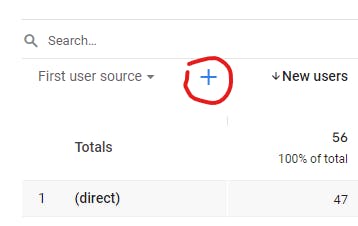Optimize Your Coverage with Secondary Dimension in Google Analytics
Optimize Your Coverage with Secondary Dimension in Google Analytics
Blog Article
Unlock Deeper Insights With Secondary Measurement in Google Analytics
With the substantial expanse of information available in Google Analytics, the usage of second dimensions can significantly improve your logical capabilities. By purposefully including second measurements right into your analysis, you can uncover valuable insights that may otherwise remain undiscovered - Secondary Dimension in Google Analytics.
Comprehending Primary Vs. Second Dimensions
When examining data in Google Analytics, it is crucial to compare primary and secondary dimensions to get deeper understandings right into customer actions. Key measurements are the primary groups through which you can watch your data, such as landing, source/medium, or tool page. These dimensions offer the fundamental framework for arranging and recognizing your information. On the other hand, second measurements permit you to additional study your main measurement information. By including a secondary measurement, you can layer on added info to your key measurement, enabling a much more granular analysis. If your main measurement is the source/medium via which customers got here on your website, adding a secondary measurement like geographical location can disclose where those users are situated geographically. This included layer of information can help you determine patterns, patterns, or anomalies that might not have appeared when taking a look at the primary dimension alone. Leveraging both additional and main dimensions in Google Analytics is vital for comprehensive information analysis and informed decision-making.
Utilizing Second Measurements Efficiently
Successfully making use of secondary measurements in Google Analytics boosts the deepness and granularity of information analysis, supplying beneficial understandings into user actions and fads. By integrating additional measurements alongside key dimensions, online marketers and analysts can dig deeper into the specifics of user interactions on their internet sites. Second measurements permit users to segment and filter key measurement information further, offering an extra detailed view of customer actions, communications, and demographics. This can be specifically valuable when attempting to understand the influence of particular variables on customer engagement, such as the web browsers or devices they are making use of, the sources of their website traffic, or their geographic areas.
Furthermore, second dimensions allow customers to compare and contrast various data factors within a single record, assisting in a much more extensive evaluation of user behavior patterns. By leveraging second dimensions properly, businesses can discover concealed understandings, enhance their marketing methods, and boost the overall individual experience on their internet sites.
Exploring Common Additional Dimension Mixes
To additionally evaluate user actions and patterns in Google Analytics, it is beneficial to discover usual combinations of additional measurements. Some usual secondary measurement mixes that offer important insights include assessing traffic resources with user areas to recognize where website site visitors are coming from geographically and just how they found the website. Examining individual habits metrics with secondary dimensions such as interests or demographics can assist in targeting specific target market sectors much more efficiently.
Applying Second Measurement in Custom Reports
Utilizing additional dimensions in custom reports enables an extra comprehensive analysis of data in Google Analytics, enhancing the depth of understandings acquired. When producing personalized records in Google Analytics, integrating second measurements can provide a more thorough sight of how various measurements communicate with each other. This function allows users to dive deeper into their data and reveal beneficial connections that may not be right away obvious.
By applying additional dimensions in custom-made records, users can gain a better understanding of their web site or application traffic. For instance, incorporating the primary measurement of "source/medium" with the secondary measurement of "touchdown page" can expose which landing pages are carrying out ideal for website traffic coming from certain resources. This insight can help online marketers enhance their projects and enhance total conversion prices.

Enhancing Information Visualization With Additional Measurement
When discovering information in Google Analytics customized reports, including second measurements not just offers a more in-depth analysis yet also boosts the graph of understandings via information visualization. By adding a secondary dimension to your reports, you can enrich the method information is provided, making it much easier to recognize patterns, fads, and relationships within your website's efficiency metrics.
Secondary dimensions can help you section your data additionally, permitting for a much deeper understanding of user habits and interactions on your site. This boosted level of granularity can be especially helpful when trying to isolate particular variables that might influence your internet site's efficiency - Secondary Dimension in Google Analytics.
Final Thought
To conclude, leveraging secondary dimensions in Google Analytics permits for a more thorough evaluation of data, leading to deeper understandings and more informed decision-making. Secondary Dimension in Google Analytics. By including check my blog additional layers of details to main information sets, analysts and marketers can uncover surprise patterns, patterns, and correlations that offer a granular view of customer behavior and interactions. This boosted degree of understanding makes it possible for optimization of campaigns and tailored methods for details target market segments, inevitably improving efficiency and conversion rates
On the various other hand, second measurements enable you to further study your primary measurement data. By including a secondary measurement, you can layer on added information to your key dimension, enabling a much more granular evaluation. If your main dimension is the source/medium with which customers arrived on your website, including an additional measurement like geographic location can disclose where those users are located geographically. By incorporating second dimensions together with main dimensions, marketing experts and analysts can dive much deeper right into the specifics of individual interactions on their web sites. Additional dimensions allow individuals to section and filter main measurement information better, using a much why not try here more in-depth sight of customer communications, actions, and demographics.
Report this page